The set-top streaming business got a little more crowded when Amazon announced the Fire TV last week. With voice-activated search, predictive content loading and a gaming "bonus feature," the Internet retail giant is positioning its new device as a cure-all usability for problems plaguing existing products.
As the newest competitor in the battle for the living room, Amazon is late to enter a field with already mature platforms. For example, Apple has its Apple TV, Google has the (arguably flopped) Google TV and Chromecast, and Roku has its own lineup of products.
Priced at $99, the Fire TV is in the same tier as other non-USB dongle streamers and comes packed with the usual assortment of video, audio and second-screen playback capabilities. It is also one of the few content consumption devices built by a subscription service provider, namely Amazon Prime.
Design
Standing only 0.7-inches tall — including a generous rubberized foot — Fire TV is thin. As seen in the picture below, the device looks a lot like a smashed Apple TV sans rounded corners.
Amazon was obviously quite inspired by Apple's set-top box as the Fire TV's design is more than just an homage with a flat matte top, high-gloss sides and buttonless facade. Whereas the Apple TV has a rubberized bottom plate, the Fire TV uses an actual piece of fairly thick rubber. Even the lone white LED status light "breathes" behind a translucent window located on the front panel.
We were initially impressed with what Amazon managed to pack into its little set-top box: Dolby 7.1 surround sound processing, optical audio out, a quad-core 1.7GHz Qualcomm Krait 300 SoC with 2GB of RAM, an Adreno 320 GPU and 8GB of flash storage. That is until we saw the AC adapter.
Unlike the Apple TV, which incorporates an AC/DC module into its small plastic shell, the Fire TV offloads the part in a square-shaped wall wart-style plug that is just large enough to be a pain.
Our A/V setup has so many wires and cables it's most likely in breach of local fire codes, so getting yet another moderately-sized plug to fit posed a challenge. We spent hours piecing together our existing menagerie of adapters in a surge protector feng shui, we dared not disrupt the delicate balance. For this test, Fire TV was powered by an extension cord from a nearby wall outlet in lieu of a more permanent solution.
Like other devices, all Fire TV controls are handled by the included Bluetooth-equipped remote, which incorporates a built-in microphone (and possibly a second, noise-canceling mic) for voice search duties. The aforementioned voice button sits at the very top directly beneath the microphone, while a large circle-shaped four-way toggle and central select button handles GUI navigation. A row of three buttons (return, home and menu) controls contextual menu and system functions, while a final row of three is mapped to audio/video transport.
The remote boasts a soft-touch coating and weight distribution feels good in the hand. It should be noted that two included AAA batteries are required for operation, so the remote is quite a bit heavier than Apple's silver IR blaster. Having a remote that doesn't require line-of-sight to operate is highly convenient and allows the Fire TV to be discreetly placemed behind an HDTV or tucked away in a cabinet.
Setup
Like other streaming products, Fire TV is ready to go right out of the box. Plug it in, connect the HDMI cable and the on-board user interface pops up asking to pair the included remote. After punching in our Wi-Fi credentials, which sadly can't be done via voice recognition (more on that later), we were greeted with about five minutes' worth of system updates.
A short introduction video explained how to use the remote and offered a brief tutorial on Fire TV's card-based GUI before slipping in an ad for Amazon Prime. Since we ordered the unit through our Prime account, the device came pre-configured with passwords and preferences in place, much like the purchase of a new Kindle.
Users can choose whether to download and sync any existing content associated with their Prime account onto Fire TV. For those invested in Amazon's cloud environment, Fire TV boasts a special section for picture viewing via Amazon Cloud Drive, which can be accessed and set up via the home screen.
Setup of individual apps like YouTube and Vevo involves authorizing access using a special number generated by Fire TV and entering it into a service's Web interface. For example, Fire TV will throw up a code for YouTube that can be entered in using YouTube's activation website.
Usage
Voice search is billed as one of Fire TV's main draws. It is the first feature listed on Amazon's comparison chart and something the company touts as being a solution to the ever-present problem of inputting text via a button-limited remote. Apple addressed this with the Remote iOS app's ability to input text via an iPhone or iPad's soft keyboard, but Amazon claims the added automation is more convenient.
The system works by capturing voice input via the remote, sending it to the cloud for processing and beaming results back to Fire TV. In our tests, recognition was dead accurate even with substantial ambient noise like fans and people chatting nearby.
There is a major issue with voice search, however. While the system itself is consistent, all content is funneled to Amazon's own store offerings, leaving third-party apps and services out in the cold. For example, when we searched for "Summit," a movie available on both Netflix and Amazon, the Netflix version was not listed as an available option.
Voice search can be activated from anywhere in Fire TV, but the results always come from Amazon's own servers. Even in the Netflix app, a search for "Summit" calls up Amazon's rental and purchase options. Basically, in its current state, voice search is an always-accessible service that does not have hooks into third-party apps.
As for the interface, Fire TV breaks down screen real estate with a persistent left-hand column of general system categories like Search, Home, Movies, TV, Apps, Settings and others. Each parent group branches into sub-categories that can be browsed or searched to find individual movies, show, games and other content. Navigation is smooth and responsive, with no apparent delay or lag.
The structure is card-based, meaning sub-categories, content and other selections are displayed as virtual cards until selected. Drilling down to a specific movie like "The Avengers" in Prime or Amazon's store will bring up a full-screen page dedicated to that title, complete with images, previews and ways to buy or rent, among other options.
Our first download was Netflix, a service to which we subscribe, followed by Vevo and a few third-party apps. Loading and installation times were minimal, with the longest wait obviously coming from rich content like games.
Prior to testing, we heard reports of spotty video playback on Netflix. Our unit, however, loaded both TV shows and movies quickly, while HD videos played back without stutter or lag. Scrubbing through a show's timeline was smooth with zero buffering time.
For reference, Fire TV was hooked up to a 100Mbps connection piped through Apple's latest AirPort Extreme mini tower and sent over the air via 802.11n Wi-Fi. The device also supports MIMO, which is especially helpful when streaming and scrubbing through 1080p HD movies.
For shows delivered through Prime, loading was even faster. The so-called "ASAP" feature "predicts" movies and TV episodes you are likely to watch next and buffers content for instant playback. In theory, Fire TV learns from your usage patterns and will become increasingly reliable as time goes by.
A testing scenario is perhaps not the best way to showcase ASAP's capabilities, especially as we moved quickly from app to app, played and paused content and constantly switched between services.
We were, however, able to "force" the feature to work in Prime's content menu by watching previews and clips from a movie just before viewing. It's amazing how much difference that little speed boost makes to the overall user experience. With ASAP active, Fire TV felt less like a set-top streamer and more like a dedicated media player.
For those who hate waiting for content to load, ASAP is a more significant advancement in streaming technology than voice search could ever hope to be. It works and it works well.
Gaming is labeled as a "bonus" feature, but Amazon is clearly making a push to bring mobile-style games into the living room. Pickings were slim at launch, with a few noteworthy titles like Minecraft-Pocket Edition and Asphalt 8 join Amazon Game Studio's own futuristic shooter Sev Zero. Most games can be played the included remote — a great example being side-scroller Badland — but ideally the sold-separately game controller would be used.
We will share a more thorough assessment of the Fire TV game controller and the system's games in a follow-up segment.
Finally, Fire TV can accept video offloaded from a Kindle HDX tablet in much the same way as an Apple TV handles AirPlay. Currently, the function is limited to Amazon's own slate and the company has not yet announced compatibility with other platforms.
Amazon XRay is also available as a second-screen experience for Kindle Fire HDX owners. The system pulls in-depth information on scenes, characters and trivia from IMDb and displays it on the Kindle while a movie is playing on Fire TV. For now, XRay support is limited to a small number of shows.
Content
Content can make or break a set-top box and luckily for Amazon, its library of TV shows and movies rivals that of Apple's iTunes. Unfortunately, Amazon Prime doesn't represent a better value than Netflix or Hulu Plus, both of which are available on other streamers.
While access to third-party providers like ESPN and Vevo was at one time a differentiator in the set-top streamer game, most services have made their way to each respective platform. Fire TV offers nearly identical support with one glaring omission: HBO Go. The popular provider with shows like "Game of Thrones" is available on Apple TV, Roku and even Chromecast.
Conclusion
Amazon's Fire TV is a well-built and executed device with a good feature set and competitive content library. With 8GB of onboard storage and the ability to download different apps, services and games, Fire TV has the potential to go toe-to-toe with the current generation Apple TV (review) and most other competing devices.
That being said, Amazon's advertised "improvements," like voice search and the ability to play bite-sized games, are not worth the $99 premium; especially so for those who already have a streaming device or don't subscribe to the $99-per-year Amazon Prime service.
Customers who are Amazon Prime members and who don't currently own a set-top box would do well in buying Fire TV. Kindle Fire HDX owners would also reap some additional benefits from the device, but it's clear what Amazon is offering.
The Fire TV is a machine designed for content consumption, more specifically content from Amazon's own store. While the company says the platform is open, so far almost all roads lead back to Amazon movie and TV show purchases, Amazon games and Amazon Prime.
If Amazon were to have offered existing and new Prime members a discount on the Fire TV — or perhaps given the box away as an added Prime bonus — the proposition would be much more enticing. Considering content selection, features and price, Fire TV is a good, but far from perfect, product. Just like the others.
Score: 3.5 out of 5
Pros
- Snappy performance
- Powerful components in a small package
- Voice search and ASAP work as advertised
Cons
- Voice search limited to Amazon results
- Same old music and video content at same old price
- No HBO Go
Where to buy
The Amazon Fire TV is available for $99 from Amazon.com, which is tax-free in all states but AZ, CA, IN, KS, KY, MA, NC, NJ, NY, ND, NV, PA, TN, TX, WA and WI.
 Mikey Campbell
Mikey Campbell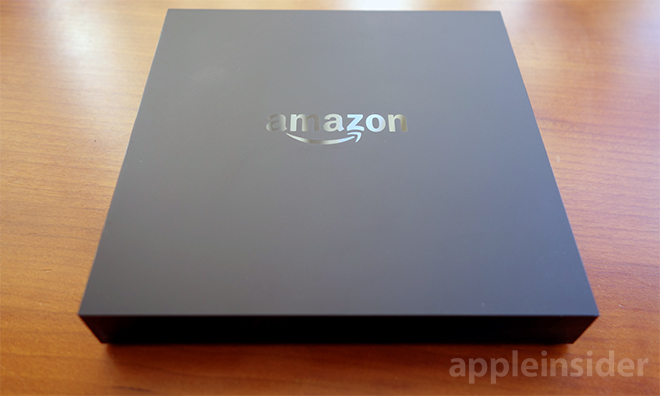
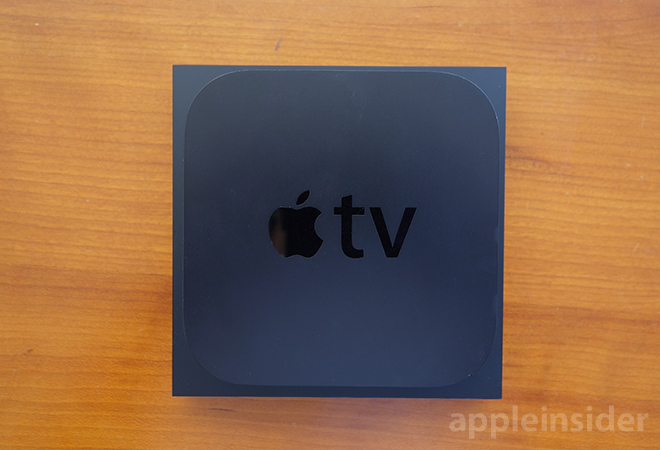

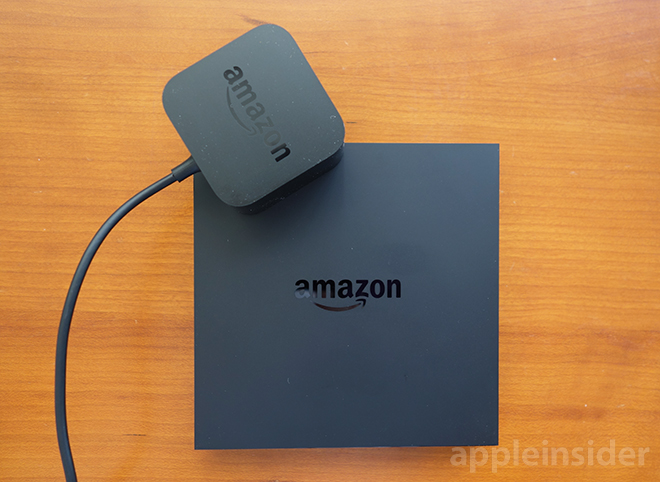

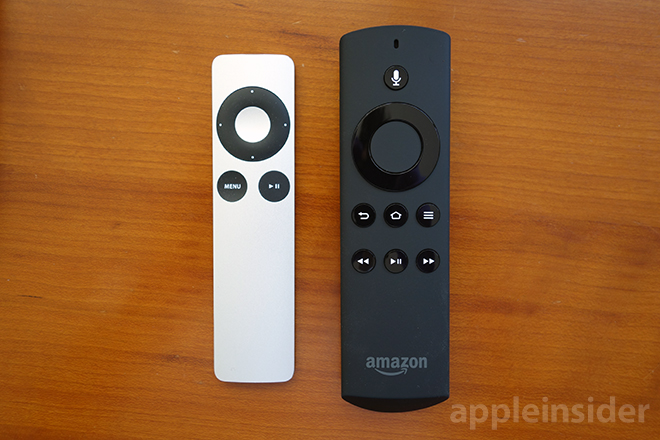
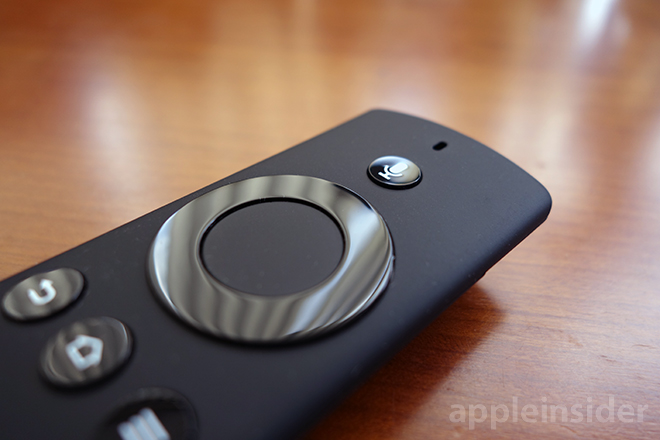
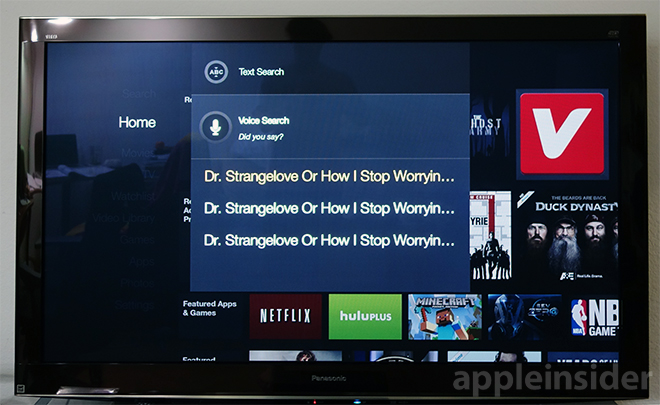

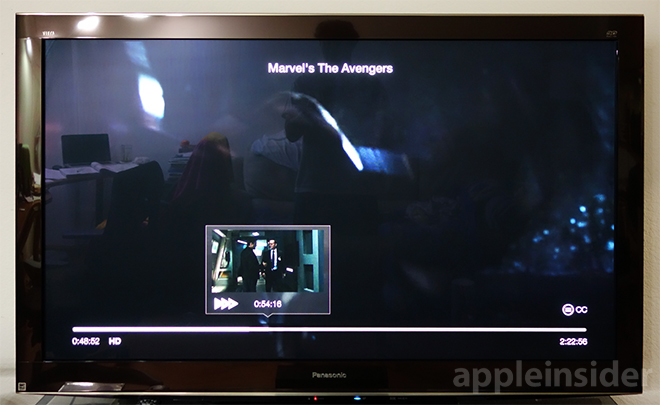
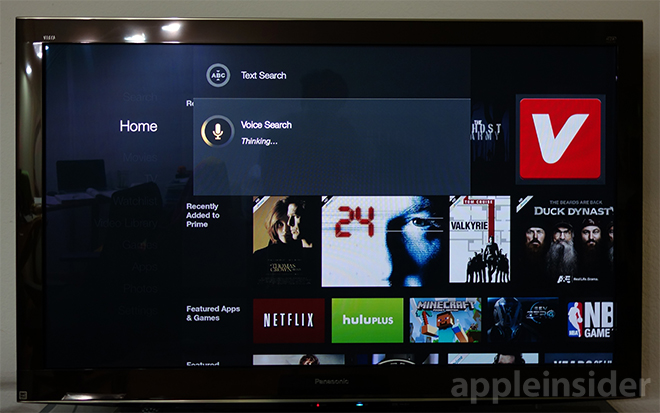
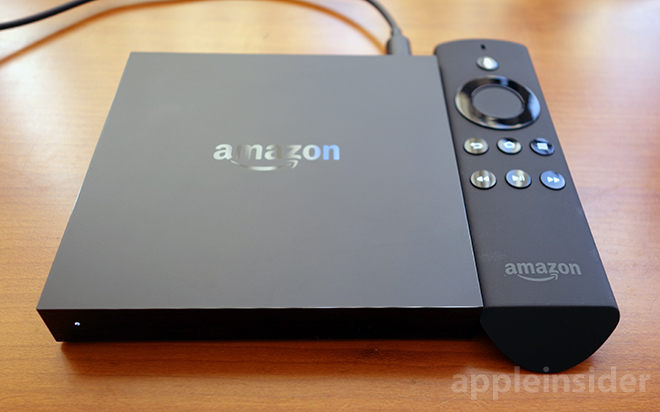








-m.jpg)






 Brian Patterson
Brian Patterson
 Charles Martin
Charles Martin


 Malcolm Owen
Malcolm Owen
 William Gallagher
William Gallagher
 Christine McKee
Christine McKee
 Marko Zivkovic
Marko Zivkovic








48 Comments
I think Prime customers w/o AppleTV or Roku would appreciate a discounted price - especially just after the subscription bump. OTOH, even as a Prime family and happy users we don't need another box in the entertainment center that adds little beyond our existing AppleTV. And they're all better than my incompetent Samsung so-called smart TV. Which I bought because of pixel quality and cpu for the price. Their idea of OS and software is years out of date.
I have seen Apple TVs placed behind the TV and remote still works great!
These two pictures seem to show dramatically different widths... Am I right or what am I missing?
I have an appleTV and xbox 360. The xbox 360 gets the most use as a media streamer / smart tv box. Amazon rocks and I like what they're doing here but I don't see what this offers beyond my xbox 360
[quote name="AppleInsider" url="/t/177769/review-amazons-fire-tv-makes-iterative-improvements-in-set-top-streaming#post_2511522"]Cons
[/quote] Gotta at least respect Amazon from not hiding the fact it doesn't have HBO GO. [IMG ALT=""]http://forums.appleinsider.com/content/type/61/id/41190/width/350/height/700[/IMG] [quote name="bro2ma" url="/t/177769/review-amazons-fire-tv-makes-iterative-improvements-in-set-top-streaming#post_2511555"]I have seen Apple TVs placed behind the TV and remote still works great![/quote] I still hope the next Apple TV comes with a BT remote. I don't care if it also has a IR sensor for backup but I'd like it to be BT.